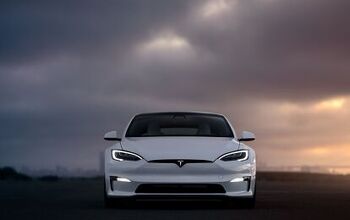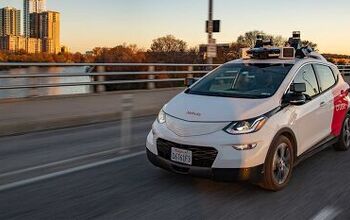1949: Architectural Illustrators Need Tailfins To Sell Buildings!

While waiting for my wife to stagger out of the dentist’s chair after a root canal, I grew bored with the October, 1994 issue of Highlights and other similar waiting-room reading material and noticed this painting on the wall. It turned out to be the illustration made by the Denver architectural firm that built the dentist’s office building, back in 1949.
Look at those fins! Harley Earl generally gets the credit for the first postwar Detroit tailfins, which went on the ’48 Cadillac. It wasn’t long before artists trying to pitch building plans started adding this futuristic styling element to the idealized cars in their illustrations. Sure, it looked dated as hell 15 years later, but by then you saw Chrysler Turbine-influenced cars gracing these paintings.
You’ve really got to admire the snazzily-dressed gentleman— no doubt heading out to his parked Caddy— giving the once-over-twice to the babe with the 11″ waist. Owooooo!

Murilee Martin is the pen name of Phil Greden, a writer who has lived in Minnesota, California, Georgia and (now) Colorado. He has toiled at copywriting, technical writing, junkmail writing, fiction writing and now automotive writing. He has owned many terrible vehicles and some good ones. He spends a great deal of time in self-service junkyards. These days, he writes for publications including Autoweek, Autoblog, Hagerty, The Truth About Cars and Capital One.
More by Murilee Martin
Latest Car Reviews
Read moreLatest Product Reviews
Read moreRecent Comments
- MaintenanceCosts Nobody here seems to acknowledge that there are multiple use cases for cars.Some people spend all their time driving all over the country and need every mile and minute of time savings. ICE cars are better for them right now.Some people only drive locally and fly when they travel. For them, there's probably a range number that works, and they don't really need more. For the uses for which we use our EV, that would be around 150 miles. The other thing about a low range requirement is it can make 120V charging viable. If you don't drive more than an average of about 40 miles/day, you can probably get enough electrons through a wall outlet. We spent over two years charging our Bolt only through 120V, while our house was getting rebuilt, and never had an issue.Those are extremes. There are all sorts of use cases in between, which probably represent the majority of drivers. For some users, what's needed is more range. But I think for most users, what's needed is better charging. Retrofit apartment garages like Tim's with 240V outlets at every spot. Install more L3 chargers in supermarket parking lots and alongside gas stations. Make chargers that work like Tesla Superchargers as ubiquitous as gas stations, and EV charging will not be an issue for most users.
- MaintenanceCosts I don't have an opinion on whether any one plant unionizing is the right answer, but the employees sure need to have the right to organize. Unions or the credible threat of unionization are the only thing, history has proven, that can keep employers honest. Without it, we've seen over and over, the employers have complete power over the workers and feel free to exploit the workers however they see fit. (And don't tell me "oh, the workers can just leave" - in an oligopolistic industry, working conditions quickly converge, and there's not another employer right around the corner.)
- Kjhkjlhkjhkljh kljhjkhjklhkjh [h3]Wake me up when it is a 1989 635Csi with a M88/3[/h3]
- BrandX "I can charge using the 240V outlets, sure, but it’s slow."No it's not. That's what all home chargers use - 240V.
- Jalop1991 does the odometer represent itself in an analog fashion? Will the numbers roll slowly and stop wherever, or do they just blink to the next number like any old boring modern car?


































Comments
Join the conversation
http://a5.sphotos.ak.fbcdn.net/photos-ak-snc1/v3207/13/19/122700371/n122700371_34247309_1198513.jpg I'm still impressed at the conceptual artist who included a BMW 850i and Citroen XM in their illustration of a Toronto condo building.
Those are my parents. Well, they remind me of my parents. Dad was one of those suit-wearing smoking guys, and Mom was a 40s babe. Nice little illustration, I think. Thanks for sharing it.